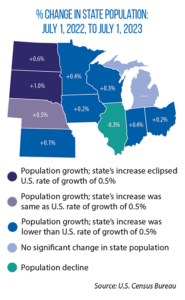Midwest projected to lose four congressional seats as population continues to move South
Population trends have returned to pre-pandemic norms, the U.S. Census Bureau says, but most of the growth is concentrated in a single region: the South. That region added more than 1.4 million residents and accounted for 87 percent of the nation’s total growth in 2023.
Over the course of this single year, southern states added 706,266 people due to patterns of domestic migration alone. Every other region was a net loser due to this movement of people within the United States: a loss of 85,729 in the Midwest (Missouri included), 323,300 in the East, and 297,327 in the West.
If these trends continue throughout the decade, “shifts in political power after the 2030 census could be among the most profound in the nation’s history,” the Brennan Center for Justice noted in a late 2023 study. It projects a loss of four U.S. House seats for the 11-state Midwest after the next congressional reapportionment: two in Illinois and one each in Michigan and Minnesota. The South would gain a total of 11 seats.
 According to the U.S. Census Bureau, nine of the 11 states in the Midwest experienced population growth in 2023, with the lone exceptions being Illinois (decline of 0.3%) and Michigan (no statistically significant change). South Dakota and North Dakota had the region’s fastest rate of population growth; Indiana added the largest number of people among the 11 Midwestern states (nearly 30,000).
According to the U.S. Census Bureau, nine of the 11 states in the Midwest experienced population growth in 2023, with the lone exceptions being Illinois (decline of 0.3%) and Michigan (no statistically significant change). South Dakota and North Dakota had the region’s fastest rate of population growth; Indiana added the largest number of people among the 11 Midwestern states (nearly 30,000).
Nationwide, the annual rate of growth was 0.5 percent, a figure higher than recent years but still historically low. In 2021 and 2022, annual rates of growth dipped to 0.2 percent and 0.4 percent, respectively, due to a rise in the number of deaths during the COVID-19 pandemic as well as decreases in immigration.
The number of live births continues to decline in the United States. A separate U.S. Census Bureau study estimates that starting in 2038, the number of U.S. deaths will begin to outpace births on a yearly basis due to an aging population and reduced fertility. This “natural decrease” will then continue throughout the rest of the century, with international immigration becoming the largest contributor to U.S. population growth.